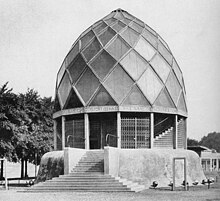
The Glass Pavilion built in 1914 by Bruno Taut was a prismatic glass dome structure at the Cologne Deutscher Werkbund Exhibition. [1][2] The structure was a brightly colored landmark at the exhibition and constructed using concrete and glass.[1][2] The concrete structure had inlaid colored glass plates on the facade that acted like mirrors.[3] Taut described his little temple of beauty as
...reflections of light whose colors began at the base with a dark blue and rose up through moss green and golden yellow to culminate at the top in a luminous pale yellow.[3]
Taut's Glass Pavilion is his best known single building achievement.[1][2][3] He built it for the association of the German glass industry specifically for the 1914 exhibition. [1][2][3] They financed the structure that was considered a house of art. [4] The structure was made at the time when expressionism stood highest in Germany.[1][2][3] There are only black and white photographs known of the building that were taken in 1914.[1] The building was destroyed soon after the exhibition since it was an exhibition building only and not built for practical use.[1][3]
The Glass Pavilion was a pineapple shaped multi-faceted polygonal designed rhombic structure.[1][2] It was a fourteen-sided base constructed of thick glass bricks used on the exterior walls devoid of rectangles.[1][2] Taut's Glass Pavilion was the first building of glass bricks of importance.[3][5]

There were glass-treaded metal staircases inside that led to the upper projection room that showed a kaleidoscope of colors.[2][4] Between the staircases was a seven-tiered cascading waterfall with underwater lighting.[1][2][4] The interior had prisms producing colored rays from the outside sunlight.[1][4] The floor to ceiling colored glass walls were mosaic.[1][4] All this had the effect of a large crystal producing a large variety of colors.[1][4]
The frieze of the Glass Pavilion was written with aphoristic poems of glass done by the anarcho-socialist writer Paul Scheerbart.[2][6]
Examples of these were
Colored glass destroys hatred. [2]
Without a glass palace, life is a conviction. [2]
Paul Scheerbart in 1914 wrote a book called Glasarchitektur ("Architecture in glass") and in turn dedicated it to Taut.[2] Taut in 1914 founded a magazine called Fruhlicht ("Dawn's Light") for his Expressionist circle of followers.[1] It focused on the iconography of glass which he drew from which is represented in his Glass Pavilion.[1] This philosophy can be traced back to accounts of Solomon's Temple.[1] An early drawing of the Glass Pavilion by Taut says he made it in the spirit of a Gothic cathedral. [7]
References
- ^ a b c d e f g h i j k l m n o p Weston, p. 40
- ^ a b c d e f g h i j k l m Watkin, p. 590
- ^ a b c d e f g Richards, p. 16
- ^ a b c d e f Colquhoun, p. 92
- ^ Anzovin, p. 15, item 1198, The first building of glass bricks of importance was the Glass Pavilion, built in 1914 in Cologne, Germany, by the modernist-socialist architect Bruno Taut.
- ^ Watkin, p. 590, The simplified frieze or string-course of the Glass Pavilion, which Taut built for the glass industry at the Deutscher Werkbund Exhibition in 1914, was inscribed with aphorisms such as "coloured glass destroys hatred."
- ^ Weston, p. 40, One of Taut's early drawings for the Pavilion describes it as having been made in the spirit of a Gothic cathedral.
Bibliography
- Weston, Richard, Plans, Sections and Elevations: Key Buildings of the Twentieth Century, Laurence King Publishing 2004, ISBN 1-8566938-2-1
- Watkin, David, A History of Western Architecture, Laurence King Publishing 2005, ISBN 1-8566945-9-3
- Richards, Brent et al, New Glass Architecture, Yale University Press 2006, ISBN 0-3001079-5-1
- Colquhoun, Alan, Modern Architecture, Oxford University Press 2002, ISBN 0-1928422-6-9
- Anzovin, Steven et al, Famous First Facts, International Edition, H. W. Wilson Company 2000, ISBN 0-8242-0958-3